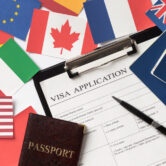
How to Apply for a Canada Work Visa: Canada Job Visa
Canada, famous for its inviting society, magnificent scenes, and strong medical care services as well as scholastic systems, has transformed into a popular destination for people searching for better opportunities. Understanding the pathways to Canada job visa and Canada Work Visa immigration choices can assist you with planning your journey.
Understanding Canada Job Visa & Work Visa
A Canada Job Visa is associated with job offers from Canadian employers who sponsor foreign workers.
A Canada Work Visa permits adaptability to work with any Canadian employer, except those on the ineligible employers list.
You must have a job offer for employment nearby, and your employer could require a Labor Market Impact Assessment (LMIA) to elaborate that selecting you won’t affect your local opportunities.
Types of Canada Work Visas
Temporary Work Permit
Issued to foreign workers with a valid job offer.
Requires an LMIA in most cases.
Valid for a limited period (usually up to 2 years, depending on the job and employer).
Open Work Permit
Allows working for any employer in Canada.
Does not require an LMIA.
Examples include Spousal Open Work Permits and Post-Graduation Work Permits.
Employer-Specific Work Permit
Restricted to a specific employer.
Requires a confirmed job offer and LMIA.
International Experience Canada (IEC) Work Permit
Available for young professionals, students, and temporary workers from select countries.
Includes Working Holiday, Young Professionals, and International Co-op permits.
Eligibility Criteria for a Canada Work Visa
Have a valid job offer from a Canadian employer (except for open work permits).
Obtain a positive LMIA (if required).
Demonstrate sufficient financial resources to support themselves in Canada.
Show no criminal record through a police clearance certificate.
Undergo a medical examination (if applicable).
How to Apply for a Canada Work Visa
Obtain a Job Offer
Secure employment from a Canadian employer.
The employer may need to apply for an LMIA.
Combine Required Documents
Job offer letter and contract.
LMIA approval (if applicable).
Passport and identification documents.
Proof of funds.
Medical exam and police clearance certificate.
Submit the Application
Apply online through the authority IRCC which is Immigration, Refugees and Canada Citizenship
Pay the required visa fees.
Biometrics & Interview (if required)
Attend a biometrics appointment.
A few candidates might be required for an interview.
Receive the Work Permit
Once approved, the work permit is issued.
Applicants can then travel to Canada and begin working.
Benefits of a Canada Work Visa
Pathway to Canadian citizenship.
The opportunity to work for any business across the country.
Access to healthcare and social benefits.
Opportunity to bring family members on dependent visas.
Exposure to a multicultural and professional environment.
Common Challenges & How to Overcome Them
LMIA Approval Delays
Work with experienced immigration consultants.
Visa Rejection
Ensure all documents are complete and correct.
Finding a Job Offer
Use platforms like Job Bank, LinkedIn, and company websites.
Frequently Asked Questions
Can I possibly apply for a Canada Work Visa without a job offer?
Without a doubt, you can apply for an open work permit at times, for instance, as a spouse of a skilled worker or an international student. However, most work visas require a proposition for employment.
What amount of time does it require to get a Canada Work Visa?
Processing times differ depending upon the sort of work permit and your home country. Overall, it can take half a month to a while.
Could I at any point I can include my family in the PR application?
Indeed, PR applications can include your spouse or common-law partner and dependent kids.
Do I have to remain in Canada persistently to keep up with my PR status?
No, however, you should live in Canada for somewhere around 730 days (2 years) over the most recent 5 years to keep up with your status.
Does having a work visa ensure PR?
No, yet it works on your possibilities, particularly when you gain Canadian work experience or qualify under the Canadian Experience Class.
Conclusion
Whether you pick a Canada Work Visa or go for the Canadian Permanent Residency, every way offers one-of-a-kind opportunities. While a work visa is the initial step for some, PR gives long-term stability and advantages. By understanding your qualifications and planning strategically, you can effectively explore the procedure and begin another life in Canada.






